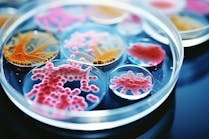The different sample types submitted to the molecular diagnostic laboratory vary in terms of their challenges relating to handling, nucleic acid extraction efficiency, likely presence of inhibitors, and similar factors. Stool specimens would fall somewhere on the more difficult end of this spectrum, and in this month’s installment of The Primer, we’ll review both why that can be, and what some of the mitigations can be.
MDx applications for stool
Let’s start, though, with a brief review of what sorts of applications might call for MDx on a stool sample. One situation might be the detection of suspected GI pathogens (bacterial, viral, or parasitic). Some of the more common suspects in this context include Salmonella, Campylobacter, C. difficile (testing for A/B toxin genes, usually), Vibrio, Shigella, enteropathic/enterotoxic/enteroaggregative E. coli, Giardia, Entamoeba, Norovirus, Adenovirus, and Rotavirus. MDx, especially through multiplex panels, is a good diagnostic tool in this context, particularly because diverse potential etiologies can present with similar symptoms. A related application, albeit at present more of a research application than front-line clinical use, is in the analysis of the gut microbiome, which appears to have wider-ranging impacts on the host than might be expected. (The “gut-brain axis,” for example, is increasingly understood to influence aspects of mood and cognition; other influences of the microbiome appear to be important in immunity and development.)
Another mainstream clinical use is in screening for colon cancer, by examining for cells containing characteristic associated nucleic acid changes. Biomarkers most frequently employed in this context include detection of mutated KRAS, TP53, APC, and microsatellite instability (MSI) markers, as well as some epigenetic markers such as abnormal DNA methylation patterns. Given the high incidence of colorectal cancers as the second- or third-most frequently diagnosed cancer type in the developed world, and literature reports of these non-invasive molecular tools achieving sensitivities and specificities in the 90 percent range, these methods are becoming increasingly useful and frequently applied tools in this context.
An inherent challenge: inhibitors
If we’re going to use stool as a sample input type for molecular assays, what are some of the challenges associated with that? First, let’s think about inhibitors. Perhaps not surprisingly, stool contains high levels of a number of well-known PCR inhibitory substances. Foremost among these is probably bilirubin, the primary breakdown product of heme from red blood cells (RBCs). The adult human body turns over roughly two to three million red blood cells per second, and as the normal breakdown path for all of that heme is via conversion to bilirubin and excretion to the GI tract, it’s a given that all stool samples contain a lot of this. Fortunately, it’s not as inhibitory as undegraded heme, and not all PCR polymerases are created equal in their sensitivity to either of these as an inhibitor. Other inhibitors commonly found in stool include complex polysaccharides, urate, and some types of lipids. (Yes, some urates are excreted in feces.)
So if inhibition is an obvious challenge in this context, what are some of the mitigations a successful MDx assay for this sample type can apply? Good extraction methods, possibly with additional wash steps compared to use on less challenging samples, is a starting point. Simple boiling lysis or direct sample-to-PCR tube methods which can work well in other sample types are less likely to be effective here. Second, some DNA polymerases are less sensitive than others to the most common inhibitors here; so if the master mix in your commercial kit or optimized lab-developed test intended for stool specimens doesn’t turn out to be the same as the one used for other sample types, don’t be surprised. (Related points would be that if you’re trying to develop an in-house test on stool-derived samples, it’s a good idea to evaluate multiple polymerase types in your development, bearing in mind that each may well have different optimal buffer, primer, and cofactor requirements; and “off-label” use of a PCR assay not explicitly validated for stool sample use isn’t likely to be very successful; don’t be surprised if you see internal control failures).
Addition of specific “PCR enhancers” or “PCR inhibition suppressor” reagents such as bovine serum albumin (BSA) or betaine can also help overcome any residual inhibition downstream of extraction. If the expected assay target is likely to be abundant, then the catch-all method for overcoming PCR inhibition—template dilution—can be of use. Finally, choice of underlying PCR method may have an impact, too. In at least one study,1 multiplexed digital droplet PCR has been specifically shown to be less susceptible to inhibition in stool sample contexts than more traditional qPCR methods.
Stool samples commonly include undigested fibrous material and insoluble materials which, while not strictly inhibitory, can also be problematic for effective extraction through effects such as clogging or occluding required nucleic acid binding surfaces (silica) common in many extraction approaches. Addition of “sample washing” steps, where sample is diluted into carrier such as phosphate buffered saline (PBS) and pre-cleared of large debris material by low-speed centrifugation (optimally, around~650 x g) with recovery of supernatant, is one way of addressing this issue and is a common pre-lysis step in many extraction protocols for this specimen type.
Another challenge: RNases
A second challenge posed by stool samples is the high prevalence of RNases. Anyone with lab experience with RNA-based assays will appreciate that this problem certainly isn’t unique to stool, as RNases are nearly ubiquitous and challenging to inactivate; but they’re particularly abundant in this sample matrix. Coupled with the presence of residual amounts of other degradative enzymes such as proteases and lipases, both host origin and from the intestinal flora, it’s a very hostile environment from which to try to recover any intact RNA. It’s not impossible, and you’ll note that some RNA viral targets were cited above in the infectious disease context, but bear in mind that those tend to be present in very high numbers, meaning that even survival of a small fraction of initial titer can be enough for detection. For less abundant targets such as those of a cellular nature, or a subset of cells (as in trying to find tumor-specific transcripts in a background of normal cells), RNA-based assays are used much less frequently than DNA-based assays.
If your test requires detection of an RNA target from stool, your best approach is to inactivate the sample as rapidly as possible. The longer the sample has to sit at or near room temperature, with residual activities lysing assay target cells and allowing RNase access to template, the worse off your detection of RNAs will be. In most cases this will mean dilution of sample into specific RNase-inactivating lysis solutions based on chaotropes such as guanidine or strong protein denaturants such as phenols. Flash freezing may also be used, but consider that unless you’re able to transfer the frozen sample directly into one of these protective lysis buffers, a freeze-thaw cycle followed by any delay may do more harm than good by increasing RNA exposure to RNases. In any case, the bottom line for this concern is rapid sample processing.
The challenge of selective growth
As it happens, that’s also the solution to yet another challenge noted in stool specimens. That is, if you’re trying to examine bacterial flora, delays between sample collection and sample extraction can allow for the selective growth of some species at the expense of others. While this can happen in other sample matrices as well, the nutrient-rich nature of stool samples makes this particularly problematic. For purely qualitative detection of selected pathogens this isn’t likely to change your end result, but for any application where quantification or relative quantification of bacterial species is needed, this can be a major confounder.
A review of this topic through PubMed reveals both that this is a widely appreciated problem (there’s a plethora of recent publications describing this exact bias), and that a priori it’s challenging to know how to interpret any such raw data on microbiota diversity and relative density, if there is much inhomogeneity in sample collection timelines either within a single study or across studies. For readers interested in a more in-depth look at this topic, a good starting point would be reference 2, which aptly asks whether this is the “elephant in the room.” While other studies have come to slightly different conclusions, this study reports significant changes in observed microbiota between immediately frozen (or analyzed) specimens as compared to those exposed to anything in excess of two days ambient temperature. With samples frozen at -80°C, the authors report few significant changes in results at time points up to two years post sample freezing. Compared to what would be ideal in an RNA recovery context, the ~48 hours acceptable ambient exposure described here is quite long; but in either context, time from sampling to stabilization and/or extraction is important in getting meaningful results, with rapid processing being ideal.
In conclusion, stool samples are a useful sample type in several MDx applications; and through careful (ideally, quick) sample handling, optimized extraction methods, and optimized assay conditions, they can be expected to provide reliable molecular test results. While DNA targets are significantly easier to assess from this matrix than RNA, it can be recovered and detected if additional processes are included.
REFERENCES
- Sedlak RH, Kuypers J, Jerome KR. A multiplexed droplet digital PCR assay performs better than qPCR on inhibition prone samples. Diagnostic Microbiology and Infectious Disease. 2014;k80(4):285-286.
- Shaw AG, Sim K, Powell E, et al. Latitude in sample handling and storage for infant faecal microbiota studies: the elephant in the room? Microbiome.2016;4:40. https://doi.org/10.1186/s40168-016-0186-x.
John Brunstein, PhD, is a member of the MLO Editorial Advisory Board. He serves as President and Chief Science Officer for British Columbia-based PathoID, Inc., which provides consulting for development and validation of molecular assays.





